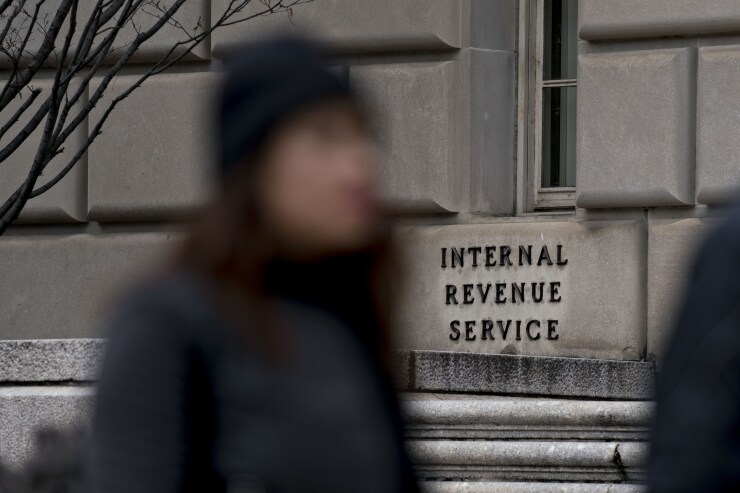The Internal Revenue Service is extending the ability to electronically sign a number of different tax forms and compliance documents through the end of October 2023.
In Memos
“As part of our response to the COVID-19 situation, we have taken steps to protect employees, taxpayers and their representatives by minimizing the need for in-person contact,” said Douglas O’Donnell, deputy commissioner for services and enforcement at the IRS. “Taxpayer representatives have expressed concerns with securing handwritten signatures during these times for forms that are required to be filed or maintained on paper. To alleviate these concerns while promoting timely filing, we are implementing a deviation with this memorandum that allows taxpayers and representatives to use electronic or digital signatures when signing certain forms that currently require a handwritten signature.”

The forms include:
- Form 11-C, Occupational Tax and Registration Return for Wagering;
- Form 637, Application for Registration (For Certain Excise Tax Activities);
- Form 706, U.S. Estate (and Generation-Skipping Transfer) Tax Return;
- Form 706-A, U.S. Additional Estate Tax Return;
- Form 706-GS(D), Generation-Skipping Transfer Tax Return for Distributions;
- Form 706-GS(D-1), Notification of Distribution from a Generation-Skipping Trust;
- Form 706-GS(T), Generation-Skipping Transfer Tax Return for Terminations;
- Form 706-QDT, U.S. Estate Tax Return for Qualified Domestic Trusts;
- Form 706 Schedule R-1, Generation Skipping Transfer Tax;
- Form 706-NA, U.S. Estate (and Generation-Skipping Transfer) Tax Return;
- Form 709, U.S. Gift (and Generation-Skipping Transfer) Tax Return;
- Form 730, Monthly Tax Return for Wagers; Form 1042, Annual Withholding Tax Return for U.S. Source Income of Foreign Persons;
- Form 1042, Annual Withholding Tax Return for U.S. Source Income of Foreign Persons;
- Form 1066, U.S. Income Tax Return for Real Estate Mortgage Investment Conduit;
- Form 1120-C, U.S. Income Tax Return for Cooperative Associations;
- Form 1120-FSC, U.S. Income Tax Return of a Foreign Sales Corporation;
- Form 1120-H, U.S. Income Tax Return for Homeowners Associations;
- Form 1120-IC DISC, Interest Charge Domestic International Sales – Corporation Return;
- Form 1120-L, U.S. Life Insurance Company Income Tax Return;
- Form 1120-ND, Return for Nuclear Decommissioning Funds and Certain Related Persons; Form 1120-PC, U.S. Property and Casualty Insurance Company Income Tax Return;
- Form 1120-REIT, U.S. Income Tax Return for Real Estate Investment Trusts;
- Form 1120-RIC, U.S. Income Tax Return for Regulated Investment Companies;
- Form 1120-SF, U.S. Income Tax Return for Settlement Funds (Under Section 468B);
- Form 1127, Application for Extension of Time for Payment of Tax Due to Undue Hardship;
- Form 1128, Application to Adopt, Change or Retain a Tax Year;
- Form 2678, Employer/Payer Appointment of Agent;
- Form 3115, Application for Change in Accounting Method;
- Form 3520, Annual Return to Report Transactions with Foreign Trusts and Receipt of Certain Foreign Gifts;
- Form 3520-A, Annual Information Return of Foreign Trust With a U.S. Owner;
- Form 4421, Declaration – Executor’s Commissions and Attorney’s Fees; Form 4768, Application for Extension of Time to File a Return and/or Pay U.S. Estate (and Generation-Skipping Transfer) Taxes;
- Form 8038, Information Return for Tax-Exempt Private Activity Bond Issues;
- Form 8038-G, Information Return for Tax-Exempt Governmental Bonds;
- Form 8038-GC; Information Return for Small Tax-Exempt Governmental Bond Issues, Leases, and Installment Sales;
- Form 8283, Noncash Charitable Contributions;
- Form 8453 series, Form 8878 series, and Form 8879 series regarding IRS e-file Signature Authorization Forms;
- Form 8802, Application for U.S. Residency Certification;
- Form 8832, Entity Classification Election;
- Form 8971, Information Regarding Beneficiaries Acquiring Property from a Decedent;
- Form 8973, Certified Professional Employer Organization/Customer Reporting Agreement; and,
- Elections made pursuant to Internal Revenue Code section 83(b).
The IRS will accept a wide range of e-signatures, including:
- A typed name typed on a signature block;
- A scanned or digitized image of a handwritten signature attached to an electronic record;
- A handwritten signature entered onto an electronic signature pad;
- A handwritten signature, mark or command entered on a display screen with a stylus; or
- A signature created by third-party software.
The IRS doesn’t specify what kind of technology a taxpayer needs to use to capture an e-signature, but it will accept images of signatures (either scanned or photographed) including common file types supported by Microsoft 365 such as tiff, jpg, jpeg, pdf, Microsoft Office suite or Zip.





